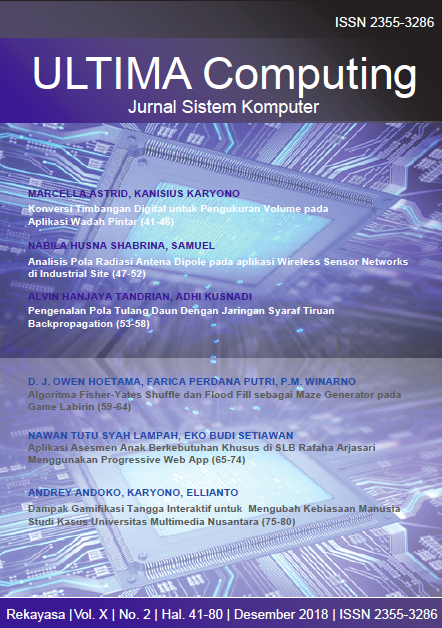Pengenalan Pola Tulang Daun Dengan Jaringan Syaraf Tiruan Backpropagation
DOI:
https://doi.org/10.31937/sk.v10i2.1063Abstract
The development of technology has affected many areas of life. Progress in the field of Computer Science can reach other aspect of science. This research apply the knowledge of Computer Science in Biological Science, the one is the morphology of leaf venation. Leaf venation is an important aspect in the process of identification. Therefore, in this research developed the
system that classify the type of leaf venation. This application is used as means of research on the performance of pattern recognition on backpropagation neural network. The system designed using the Java programming and socket programming to transfer data from the mobile device into the computer. Data testing is implemented using Android to facilitate process of
taking the picture. While in the process of training data for the optimal weight applied directly on the server computer by using Java Eclipse. In the stage of image processing is implemented by using the library of Canny edge detection. Data consisted of five categories of leaf vein pattern, with a sample of three leaves for each pattern. Training data using two of the three leaves for each pattern, with 10 images each leaf so that there are 20 images for each pattern, with a total of 100 images for all patterns. Data testing use 10 images from the third leaf to count the accuracy. The system managed to get
the best accuracy by using an image size of 200 x 200 with 100 hidden node with the average accuracy of 76%.
Index Terms” Android, Canny Edge Detection, Java, Neural Networks Backpropagation, Socket Programming
Downloads
Downloads
Published
How to Cite
Issue
Section
License
Authors retain copyright and grant the journal right of first publication with the work simultaneously licensed under a Creative Commons Attribution-ShareAlike International License (CC-BY-SA 4.0) that allows others to share the work with an acknowledgment of the work's authorship and initial publication in this journal.
Authors are able to enter into separate, additional contractual arrangements for the non-exclusive distribution of the journal's published version of the work (e.g., post it to an institutional repository or publish it in a book), with an acknowledgment of its initial publication in this journal.
Copyright without Restrictions
The journal allows the author(s) to hold the copyright without restrictions and will retain publishing rights without restrictions.
The submitted papers are assumed to contain no proprietary material unprotected by patent or patent application; responsibility for technical content and for protection of proprietary material rests solely with the author(s) and their organizations and is not the responsibility of the ULTIMA Computing or its Editorial Staff. The main (first/corresponding) author is responsible for ensuring that the article has been seen and approved by all the other authors. It is the responsibility of the author to obtain all necessary copyright release permissions for the use of any copyrighted materials in the manuscript prior to the submission.















